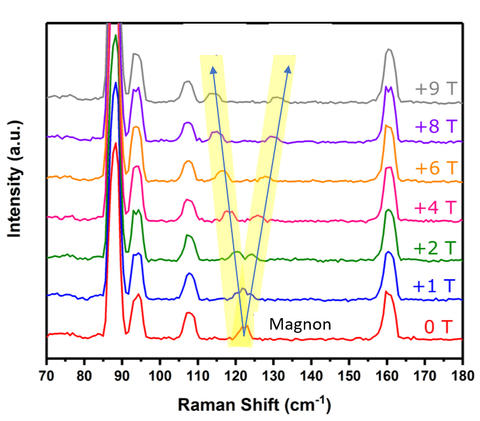Researchers at the National Institute of Standards and Technology (NIST) have discovered a surprising feature in two-dimensional (2D) magnets, a new class of materials receiving a great deal of attention. Their finding is the first verification that a signal long thought to be due to vibrations in the lattice - the structure of the material itself - is actually due to a wave of electron spins.
Some materials are composed of layers that interact very weakly, which allows scientists to pull apart or isolate individual layers and access atomically thin (on the order of a few nanometers), 2D sheets. For example, graphene was the first 2D material isolated from graphite. The more that scientists learn about these 2D materials, the closer they are to realizing potential applications, especially in next generation electronics and even quantum information.
The NIST team published their results today in Physical Review B.
Transistors are the building blocks of all modern-day electronics, where information is stored and transferred via movement of electrons. The flow of these electrons results in the generation of a significant amount of heating, which is why laptops get hot with extended use.
One prospect for solving this heat issue is using waves of spins, called magnons, as the information carrier in devices instead of moving electrons. Future technology based on magnons, or "magnonics," would then ideally function with little to no heating.
The NIST work lays the foundation for future applications by establishing a measurement technique to study the fundamental physics of magnons. The NIST team says 2D device engineers will be particularly excited about the high frequency at which the magnon is observed. This is important in determining the switching speed in potential magnon-based devices (for example, devices that work in the THz rather than the GHz range).
A Unique Approach
The study of 2D materials has flourished into its own branch of condensed matter physics, even though the first 2D material, graphene, was only isolated in 2004, said NIST project leader Angela Hight Walker. These materials are called 2D because while they can be micrometers wide, they are extremely thin - thin as a single atom or 100,000 times smaller than a human hair. Their nanometer-scale thickness allows for more customizability than 3D materials, where dramatic differences can be seen even between one and two layers of the same material.
"One of the exciting things about investigating these 2D materials is there are so many different ways to tune them," or control their behavior, said NIST physicist Amber McCreary. "For example, because they are so physically flexible, researchers can apply large amounts of strain to change their properties, which is a tuning mechanism you wouldn't have in a thicker, more rigid material."
Using 2D materials also allows scientists to create heterostructures - sandwiches of thin materials stacked on top of each other layer by layer. Interactions between the different layers create customizable behavior too, for example causing graphene to become superconducting when the layers are rotated by some "magic angle" relative to one another.
But until recently, no one thought layered materials could be magnetic when you reduce their size down to the 2D limit. Then, just a couple of years ago, it was discovered that some of them could, in fact, keep their magnetic behavior in a single layer, and the field "exploded with interest," McCreary said.
In the wake of this breakthrough, Hight Walker and McCreary immediately saw the potential to investigate some of these 2D magnetic materials using their unique Raman spectroscopy system.
Raman spectroscopy is a technique that probes a sample with laser light and then measures how that light is scattered by the sample, revealing information about a 2D material such as its structure, defects, doping, number of layers and coupling between the layers, and more. Researchers visualize the data they gather as a spectrum, a graphical representation of all the frequencies being measured. A typical spectrum would have peaks representing a strong signal at certain frequencies of light.
In addition to all the capabilities of conventional Raman spectroscopy, the custom-engineered system at NIST adds the ability to simultaneously track the scattered light as a function of both temperature (down to 1.6 K) and magnetic field (up to 9 Tesla).

The NIST scientists chose to explore the 2D magnet FePS3 because its Raman spectra changes dramatically when it becomes magnetic at low temperatures. At around 120 K (about -240 degrees F), the spins from each Fe atom prefer to align opposite their neighbor; this configuration is called antiferromagnetic, as opposed to ferromagnetic where all the spins align in the same direction.
While conducting their experiments, they found that one of the peaks in their Raman spectra was behaving unexpectedly.
A Detective Story: Magnon or Phonon?
The crux of this work requires appreciating the difference between two kinds of collective excitations, phonons and magnons.
Phonons are quantized lattice vibrations in a material, where the word quantized is used to mean that only certain frequencies of vibrations are allowed. In this animation, you can see how this vibration propagates through the structure of a one-dimensional (1D) chain of atoms, with some atoms getting closer to each other, then farther away, as the material vibrates.

Magnons, on the other hand, do not involve motion of the atoms themselves. Instead, magnons involve changes to a quantum property of electrons in the atoms called spin, the feature that makes magnets magnetic. If you think of each atom as being a compass, then spin is (metaphorically) the needle of the compass. In this metaphor, however, the spin can point both north (up) and south (down). The animation below shows a cartoon of a magnon, which can happen when the spins are perturbed by the laser light. You can see how the arrows have a rippling motion that is analogous to the spins in a magnetic material in this sample 1D chain. This excitation of the spins is called a spin wave.

When you measure the Raman spectrum of magnetic materials, both phonons and magnons can show up as individual peaks which are indistinguishable at first. It takes advanced investigative techniques, including studying the features while simultaneously tracking their response to temperature and magnetic field, to truly discern the two. Previously, the research community had identified one particular peak in the Raman spectrum of FePS3 as a phonon. But by changing the temperature and magnetic field strength, the NIST team discovered two odd behaviors.
First, the frequency change of the peak was larger than expected as a function of temperature. And then when they applied a larger and larger magnetic field, the feature they were tracking surprisingly splits into two peaks.

Neither of these behaviors are expected from a phonon. But they are classic magnon behavior.
"Our study is the first to confirm the presence of a magnon in a 2D magnet, and our unique experimental capabilities made it possible," said Thuc Mai, a National Research Council postdoctoral fellow and paper co-author.
Where Do We Go From Here
One of the main takeaways of this work is that other researchers should consider magneto-Raman spectroscopy as a key measurement technique to probe 2D magnets and other quantum materials, Hight Walker said.
"We know of at least three labs that are adopting similar configurations after hearing us present the details of our unique capabilities," Hight Walker said. "So it is exciting that people are seeing the promise."
"NIST was the first to leverage our magneto-optical cryostat with such advanced Raman spectroscopy," said Balázs Sipos, head of customer success at Attocube, a company that develops, produces, and distributes components and systems for nanoscale applications. "We have seen several more labs interested in duplicating their set up to achieve these unique types of measurements."
As new information about these new materials is unraveled, more applications will be realized. Right now, the 2D magnets are so new that scientists are still diving into the underlying physics. But computing systems based on magnetism instead of electronics could be a potential high-risk, high reward outcome.
"We're doing the groundwork in understanding how optics can be used to study these materials that have been called out as relevant quantum materials for investigation," Hight Walker said. "As we're beginning to demonstrate, this technique is going to be key for quantum materials metrology."






